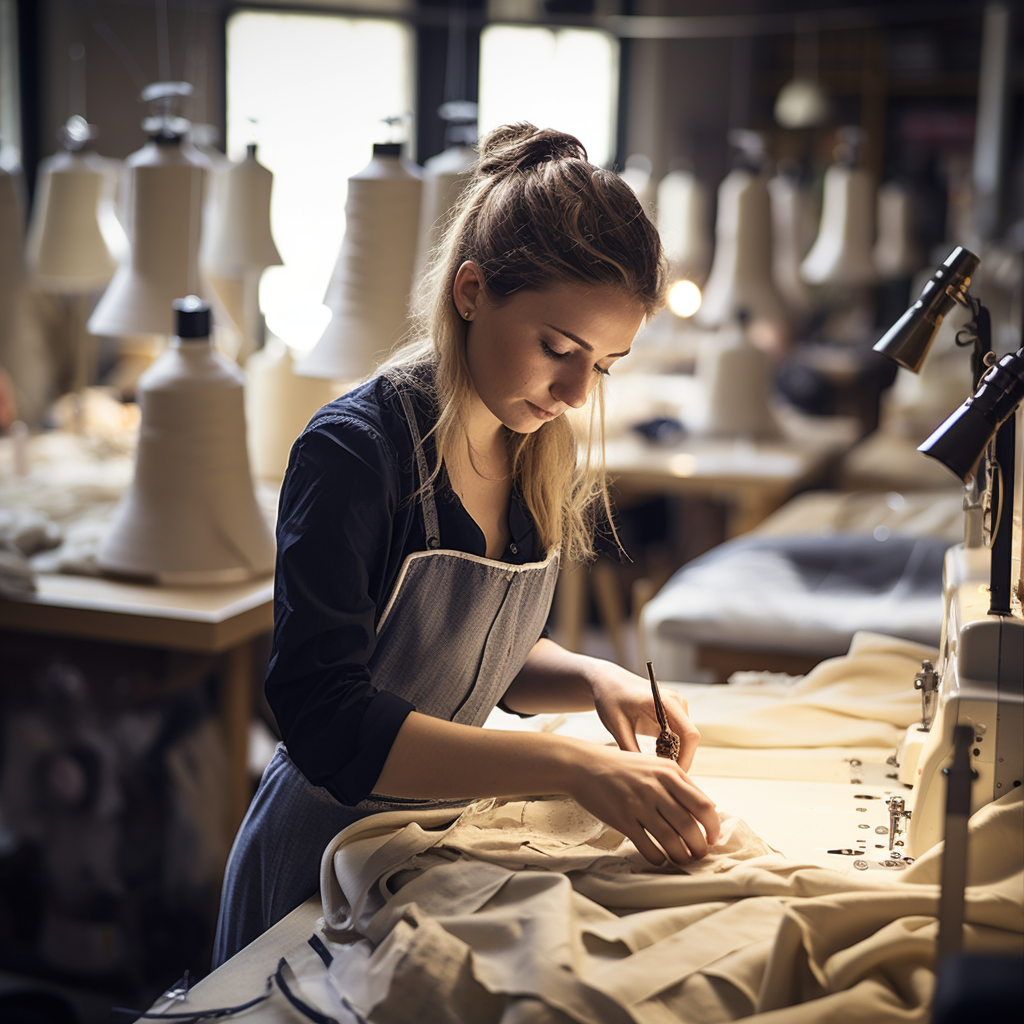Mastering Garment Manufacturing: A Startup Guide


The Importance of Clothing Making Techniques
Clothing making techniques are the foundation upon which the fashion industry is built. They play a pivotal role in determining the quality, durability, and overall appeal of garments. For startup manufacturers, understanding and mastering these techniques is crucial, as it impacts the reputation and success of their budding brands. Delving deep into the different stages of garment manufacturing enables startups to create products that resonate with consumers and stand the test of time.
The Role of Startups in the Fashion Industry
In recent years, startups have become significant players in the fashion industry, bringing innovative designs and sustainable practices to the forefront. They are increasingly challenging established brands, offering fresh perspectives and addressing the evolving needs and preferences of consumers. The dynamic and nimble nature of startups allows them to adapt quickly to market trends, thus positioning themselves as trendsetters in the fashion landscape.
Overview of Clothing Manufacturing Processes
The process of clothing manufacturing is intricate and multifaceted, involving various steps such as fabric selection, pattern making, cutting, sewing, and quality control. Each step is interdependent and requires meticulous attention to detail to ensure the final product meets the desired standards of quality and aesthetics. Grasping the intricacies of each process is imperative for startup manufacturers to navigate the complexities of garment production efficiently and to establish a solid footing in the competitive fashion market.
Understanding Fabric and Material Selection
Fabric Types and Their Uses
Fabric selection is a crucial step in the garment manufacturing process, impacting the appearance, texture, and durability of the final product. Startups need to be well-versed in the plethora of fabric types available, each with its unique properties and uses. Common fabric types include cotton, known for its breathability and comfort; polyester, valued for its durability and resistance to wrinkles; and silk, renowned for its luxurious feel and natural sheen.
Selecting the right fabric requires a deep understanding of the garment’s intended use, desired aesthetic, and required durability. For instance, active wear manufacturers might prefer synthetic fibers like polyester for their moisture-wicking properties, while luxury brands may opt for natural fibers like silk or cashmere for their unparalleled softness and luster.
Importance of Sustainable Fabrics
With growing environmental consciousness, the demand for sustainable fabrics is on the rise. Consumers are increasingly seeking eco-friendly options, placing pressure on manufacturers to adapt their practices. Sustainable fabrics, such as organic cotton, bamboo, and hemp, are not only environmentally friendly but also offer unique textures and properties, often being more breathable and hypoallergenic compared to their conventional counterparts.
Startups, with their inherent agility and adaptability, have the opportunity to lead the way in sustainable fashion. By embracing eco-friendly materials and practices, they can cater to the burgeoning market of conscious consumers and set new standards in sustainability within the fashion industry.
The Role of Material in Quality Assurance
The quality of materials used in garment manufacturing directly affects the overall quality of the final product. High-quality fabrics are less likely to fade, shrink, or wear out, ensuring longevity and customer satisfaction. Conversely, poor-quality materials can lead to subpar products, damaging the brand’s reputation and customer trust.
For startup manufacturers, investing in quality materials is paramount. It not only helps in building a positive brand image but also fosters customer loyalty. By prioritizing quality from the get-go, startups can distinguish themselves from competitors and establish a strong presence in the market.
Pattern Making and Designing
Basic Principles of Pattern Making
Pattern making is a blueprint for garment creation, a pivotal phase where the design comes to life. A pattern is essentially a template from which fabrics are traced and cut, forming the pieces that will be sewn together to create the garment. Understanding the principles of pattern making—such as darts, seams, and allowances—is crucial for startups to ensure the fit, symmetry, and proportion of the garments are accurate.
Mastering the basics, like drafting, grading, and altering patterns, allows startups to develop designs that are both innovative and functional. Knowledge of pattern making also aids in minimizing fabric waste, which is vital for both cost efficiency and sustainability.

The Impact of Design on Manufacturing
Design is not just about aesthetics; it significantly influences the manufacturing process. The complexity of a design affects the time, skills, and resources needed to produce a garment. Elements like pleats, layers, or embellishments can enhance the garment’s appeal but can also complicate the production process.
Startups must strike a balance between design innovation and manufacturability. Creating visually striking designs that are also feasible to produce is crucial for maintaining production timelines and budgets. Thoughtful design can facilitate the manufacturing process, reducing errors and revisions, and ultimately leading to a more cohesive and harmonious final product.
The Interplay between Creativity and Functionality
In the realm of fashion design, creativity and functionality must coexist. A garment can be artistically profound, but if it lacks comfort or practicality, it may not resonate with the consumers. The successful integration of innovative design with wearability and utility is a hallmark of successful fashion brands.
For startup manufacturers, exploring this delicate balance is vital. It involves conceptualizing designs that are not only visually appealing and distinctive but also user-friendly and versatile. The synthesis of creativity and functionality in garment design can lead to the development of unique products that captivate consumers and meet their diverse needs.
Cutting and Sewing
Overview of Cutting Techniques
Cutting is the process where the fabric is shaped according to the pattern, and it’s a critical step to ensure the precision of the garment's pieces. Employing accurate cutting techniques is vital as it influences the ease of sewing and the appearance of the finished product. Various cutting methods, like die-cutting, hand cutting, and laser cutting, are used depending on the fabric type, design complexity, and production volume.
For startups, mastering cutting techniques is essential to avoid costly errors and material wastage. An accurate cut ensures a smoother sewing process and contributes to the overall quality and aesthetics of the garment.
Sewing Methods and Their Importance
Sewing is where the cut pieces of fabric are joined together to form the garment. The stitching needs to be secure and neat, requiring skilled craftsmanship or advanced sewing machinery. Different sewing methods, such as overlock, flatlock, and lockstitch, are employed based on the garment type and design requirements.
Sewing is pivotal in garment manufacturing, as it affects the durability and appearance of the finished product. For startup manufacturers, a focus on meticulous stitching and seam quality is crucial in producing garments that meet high standards and customer expectations.
Advanced Sewing Technologies
The advent of technology has revolutionized the sewing process, introducing machines that can perform intricate stitches with speed and precision. Automated sewing machines and computerized systems have enabled manufacturers to enhance productivity, maintain consistency, and reduce manual errors.
Startups, by leveraging advanced sewing technologies, can gain a competitive edge in the market. These technologies allow for the efficient production of complex designs, enabling startups to explore creative possibilities while maintaining high levels of precision and quality in their products.
Quality Control and Assurance
The Importance of Quality Control
Quality control is integral in garment manufacturing, serving as the gatekeeper for maintaining standards and preventing defective products from reaching the consumer. It involves meticulous inspection and testing of garments to ensure conformity to design specifications, sizing accuracy, and overall workmanship quality. The process helps in identifying any discrepancies or defects early on, allowing for timely rectifications.
Startups, striving to establish their brand reputation, cannot afford to compromise on quality. Implementing stringent quality control measures is paramount in building consumer trust and sustaining long-term success in the competitive fashion industry.
Techniques for Assuring Quality
Several techniques can be employed to assure quality in garment manufacturing, including visual inspection, measurement checks, and testing for fabric strength, colorfastness, and shrinkage. Utilizing a combination of manual inspections and technological tools ensures a thorough examination of every garment, warranting compliance with quality standards.
Startups need to incorporate a multifaceted approach to quality assurance, adapting techniques that align with their production scale, design complexity, and brand values. By being proactive in quality assurance, startups can mitigate the risks of returns and recalls, fostering customer satisfaction and loyalty.
The Role of Quality Assurance in Brand Building
Quality assurance is not merely a corrective process; it’s a brand-building strategy. It reflects a brand’s commitment to excellence and customer satisfaction. A consistent track record of high-quality products elevates a brand’s image, differentiates it from competitors, and encourages customer retention and word-of-mouth referrals.
For startup manufacturers, embedding quality assurance in their organizational culture is crucial. It enables them to instill confidence in their consumers, enhance their market positioning, and create a solid foundation for scaling their business in the future.
Sustainable Practices in Garment Manufacturing
Sustainability: A Modern Imperative
In the current climate of environmental and ethical awareness, sustainability in garment manufacturing has transformed from a trend to an imperative. It involves the incorporation of eco-friendly materials, ethical labor practices, and energy-efficient production processes, aiming to minimize the ecological footprint of the fashion industry. Startups in the fashion industry have a unique opportunity to integrate sustainability from their inception, aligning their brand ethos with environmental conservation and ethical consciousness.
Eco-friendly Materials and Processes
The utilization of sustainable materials like organic cotton, recycled polyester, and Tencel is a pivotal aspect of sustainable garment manufacturing. These materials are produced with minimal environmental impact, reducing water usage, chemical consumption, and carbon emissions. Additionally, embracing eco-friendly dyeing and finishing processes further mitigates the environmental impact, contributing to the overall sustainability of the products.
Startups that prioritize the use of sustainable materials and processes not only appeal to environmentally conscious consumers but also contribute to the global effort to combat environmental degradation and climate change.
Ethical Labor and Production Practices
Sustainable garment manufacturing also encompasses ethical labor and production practices. This includes ensuring fair wages, safe working conditions, and adherence to labor rights, fostering a humane and equitable working environment. Ethical production practices extend to the responsible management of resources, waste reduction, and energy conservation in the manufacturing process.
By embracing ethical and responsible practices, startup manufacturers can build a positive brand image, foster employee satisfaction and loyalty, and appeal to a growing segment of socially conscious consumers.
The Long-term Impact of Sustainable Practices
Adopting sustainable practices has long-term benefits for both the brand and the environment. It enhances brand reputation, attracts like-minded consumers, and fosters brand loyalty. Moreover, it contributes to environmental conservation, social equity, and ethical business practices, paving the way for a more sustainable and equitable fashion industry.
Startups embracing sustainability can play a pivotal role in shaping the future of fashion, championing innovative solutions, and driving the industry towards a more responsible and sustainable path.
Marketing and Branding for Startup Manufacturers
Creating a Strong Brand Identity
For startup manufacturers, establishing a strong and cohesive brand identity is essential to differentiate themselves in the competitive fashion market. A brand identity is a visual and conceptual representation of the brand, encompassing elements like logo, color palette, typography, and brand voice. It should reflect the brand’s values, mission, and personality, creating a unique and memorable impression on consumers.
Building a consistent and compelling brand identity aids in creating brand recognition and loyalty, fostering a sense of trust and connection with the target audience. It is the foundation upon which all marketing strategies are built, and it informs the brand's presence across various platforms and touchpoints.
Digital Marketing Strategies
In the digital age, leveraging online platforms is crucial for brand visibility and customer engagement. Effective digital marketing strategies include Search Engine Optimization (SEO), Social Media Marketing, Content Marketing, and Email Marketing. These strategies aim to drive traffic, generate leads, and convert prospects into customers, utilizing the vast reach and targeting capabilities of the digital landscape.
Startups must formulate and execute digital marketing plans that align with their brand identity and business goals. By optimizing their online presence and engaging with their audience through valuable and relevant content, they can build a community of loyal followers and advocates.
Importance of Customer Engagement
Engaging with customers is pivotal in building relationships and understanding their needs and preferences. Interaction through social media, surveys, and feedback forms helps in gauging customer sentiments and gathering insights on their preferences and expectations. It allows brands to tailor their offerings, improve their services, and enhance the overall customer experience.
For startups, customer engagement is a valuable tool for learning and improvement. It enables them to adapt to the market dynamics, innovate based on customer inputs, and create products that resonate with their target audience.
Sustainable and Ethical Branding
Given the growing concern for sustainability and ethics in fashion, integrating these values into the brand’s narrative is increasingly important. Promoting sustainable practices, ethical production, and social responsibility enhances brand image and appeals to conscious consumers. It not only distinguishes the brand in a crowded market but also fosters a deeper connection with consumers who share similar values.
Startups embracing sustainability and ethics in their branding can position themselves as pioneers in responsible fashion, gaining credibility and trust among discerning consumers.

Conclusion and Future Perspectives
Embracing Innovation
In the ever-evolving landscape of fashion manufacturing, embracing innovation is crucial for survival and growth. Startups must be agile and receptive to new technologies, materials, and methodologies that can enhance their efficiency, quality, and sustainability. By fostering a culture of innovation and continuous improvement, startups can stay ahead of the curve, adapt to changing market dynamics, and meet the rising expectations of consumers.
Building Resilience
The unpredictable nature of the fashion industry demands resilience. Startups need to build robust business models, diversify their product range, and optimize their supply chains to navigate through uncertainties and disruptions. A resilient approach enables startups to recover from setbacks, learn from challenges, and emerge stronger and more adaptable in the face of adversity.
Fostering Sustainability
The importance of sustainability in the fashion industry cannot be overstated. It is no longer an optional attribute but a fundamental requirement. Future-forward startups must prioritize sustainability in every aspect of their business, from material selection to production processes, labor practices, and end-of-life management. The commitment to sustainability is not just an ethical responsibility; it is a strategic imperative for building a resilient and future-proof business.
Cultivating Brand Authenticity
In a world inundated with brands vying for consumer attention, authenticity is the differentiator. Startups must cultivate authenticity by staying true to their values, being transparent about their practices, and delivering on their promises. Authenticity builds trust and loyalty among consumers, fostering lasting relationships and creating brand advocates.
Anticipating Consumer Needs
Understanding and anticipating consumer needs is essential for creating products that resonate with the target audience. Startups must engage with their consumers, gather insights, and stay attuned to emerging trends and preferences. By being consumer-centric, startups can innovate responsively, tailor their offerings, and create value that aligns with the evolving needs and aspirations of their audience.
Summary:
In conclusion, the journey of startup manufacturers in the garment industry is fraught with challenges but also ripe with opportunities. By integrating cutting-edge technologies, adhering to quality standards, incorporating sustainable practices, building a strong brand identity, and staying consumer-focused, startups can navigate the complexities of the fashion industry and establish themselves as reputable, sustainable, and innovative brands. The future of fashion belongs to those who can blend creativity with responsibility, authenticity with quality, and innovation with sustainability.
This concludes our exploration of clothing making techniques for startup manufacturers. If there are any more details or specific topics you would like to explore, feel free to ask.





-500x500.jpg)
-500x500.jpg)
-500x500.jpg)
-500x500.jpg)
-500x500.jpg)